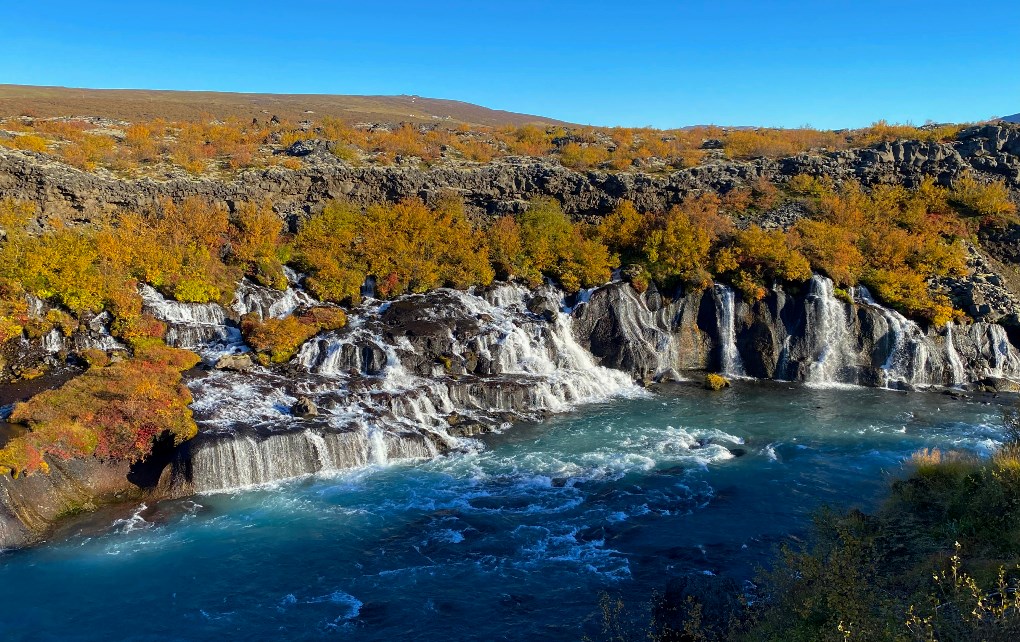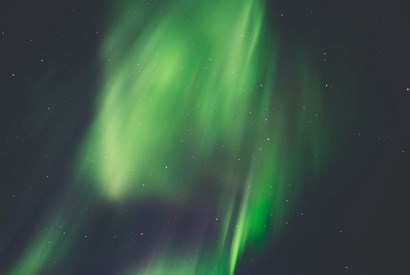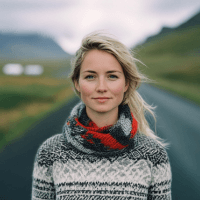Top 10 Waterfalls in Iceland & How to Visit Them By Car

Iceland is filled with beautiful, world-renowned waterfalls. From Gullfoss (considered Iceland’s most beautiful) to Glymur (Iceland’s second-tallest waterfall), Skogafoss to Seljalandsfoss, Iceland has more than 10,000 waterfalls, and each is unique.
Travellers come from all around the world to see Iceland’s waterfalls (much like they do for our volcanoes and glaciers!), and if you’re one of these travellers, you might have some questions.
- What are the best waterfalls to see in Iceland?
- How do you visit Iceland’s waterfalls?
- Is it possible to self-drive to Iceland’s waterfalls on your own?
- What about planning an Iceland waterfalls road trip? How do I do that?
To help you plan the best Iceland waterfalls itinerary, we’re pulling together our top 10 favourites, as well as tips on how to visit them by car, if you are planning to rent a car in Iceland.

6 Quick Facts About Iceland Waterfalls
- There are more than 10,000 waterfalls in Iceland.
As mentioned above, there are more than 10,000 waterfalls in Iceland. Fed by Iceland’s multitude of ice, snow and glaciers, the waterfalls are active nearly all year long. However, while Iceland has 10,000-plus waterfalls, only around 200 of them are named falls.
- Iceland’s tallest waterfall is 228 metres tall.
Iceland’s tallest waterfall is 228 metres (or 748 feet). This waterfall, Morsarfoss, has not always been the tallest waterfall, though. It was only named the country’s tallest in 2011, when it first became visible in 2007, as glacier ice melted, revealing the water flow (which, scientists guess, could be even taller than 228 metres, if there are still parts of the falls that aren’t visible to the naked eye).
Before Morsarfoss took the tallest-waterfall ranking, Glymur stood as the largest, at 196 metres.
- You can visit Iceland’s waterfalls any time of year.
While you might assume that Iceland’s waterfalls are completely frozen over and inaccessible in winter, that’s not always the case with all of the island’s waterfalls. You can visit in either the summer or the winter, to enjoy the Iceland waterfall experience.
In the summer, from late May to early September, you can enjoy the full volume of roaring water, as well as rainbows and great weather conditions for hiking around the falls. Come in the winter, though, and you’ll be treated to winter wonderland-esque conditions, with lots of snow and ice.
- What’s the best waterfall in Iceland?
As mentioned above, often, Gullfoss waterfall is considered Iceland’s “most beautiful” waterfall (though keep in mind that beauty is in the eye of the beholder, so you may very well decide you like another waterfall more!). The name means “Golden waterfall” and it’s one of Iceland’s most famous tourist sites.
- Which Iceland waterfall can you walk behind?
If you’ve done any research at all ahead of your Iceland trip, you may have heard about this waterfall that you can walk behind. That waterfall is Seljalandsfoss. If you’re interested in seeing it, you can find it right off the Ring Road, during an easy day trip from Reykjavik or during your journey along Iceland’s South Coast.
- Are waterfalls free to visit in Iceland?
Yes! The waterfalls are free to visit. The only costs that you may incur are fees associated with parking or entering nearby facilities where you’ll find amenities such as restrooms.
Map of Iceland’s Waterfalls
Iceland’s Most Famous Waterfalls + How to Visit Them
Ready to get on the road and see Iceland’s most famous waterfalls? Here are our top 10 favourites and how to see each.
1. Gullfoss

So you want to see Iceland’s most beautiful waterfall? The “golden waterfall?” Luckily for you, visiting Gullfoss is very easy.
Situated in Southwest Iceland, in a river canyon and made up of two drops, the waterfall sits on the Golden Circle, making it especially easy to visit if you’re already exploring the route or if you’re just travelling around to some of Iceland’s most popular spots.
Because the roads are in great condition and so popular with tourists, you’ll find that even small 2WD vehicles can make the trip to the waterfall, making this site even more popular with budget-friendly travellers who don’t want to pay extra for a 4x4 car that can take them further. The waterfall is free, open and visible all year round (it’s even open at night!), though you should expect that some of the viewing points will be closed in bad winter weather. Additionally, visibility is restricted in winter, too, and you might need crampons for your hiking boots during particularly icy conditions. (In other words, while it’s possible to visit Gullfoss in the winter, most like it best in the summer).
In general, plan to spend about four hours visiting the waterfall, including drive time to and from Reykjavik. If you want to avoid crowds, visit either in the morning or evening.
2. Seljalandsfoss

Recognizable from many photos and one of Iceland’s most popular waterfalls, Seljalandsfoss is only 60 metres tall (200 feet), but it is known as being a waterfall that you can walk all the way around.
Just like with Gullfoss, Seljalandsfoss is very easy for travellers to reach, as it sits right off the Ring Road. Because of the road’s good conditions and popularity, you can access it all year round and with 2WD vehicles. If you are visiting during the winter, though, crampons are advised, to account for the ice. Regardless of when you visit, however, you’ll want a waterproof outer layer of clothing, to keep you dry if you decide to walk behind the falls. (And do note that the path behind the waterfall may close during hazardous wintery weather).
While you’re visiting Seljalandsfoss, make sure to stop off by Gljufrabui, another nearby, hidden waterfall in a deep gorge, which you can see after a brief walk inside a canyon.
It takes about two hours to drive from Reykjavik to Seljalandsfoss. Anticipate a parking fee of 800 ISK ($6.11 USD or 5.42 EUR).
3. Skogafoss

Located off Route 1 and on Iceland’s South Coast, Skogafoss is another easily accessible Iceland waterfall that impresses with its height and width, standing at 60 metres tall (197 feet) and 25 metres wide (82 feet). The dramatic size and the fact that you can walk right up to the falls makes for a great photo op!
Because of the waterfall’s location, you can access it every time of year, though be careful during the winter months. Things can get slippery and you’ll want to wear crampons. Even if you’re not visiting during the winter, though, you’ll want a waterproof outer layer of clothing if you plan on approaching the falls.
If you’re travelling from Reykjavik, you can expect to reach Skogafoss in about two hours (though we recommend pairing a visit to Skogafoss with a visit to Seljalandsfoss, as they’re only about a 30-minute drive apart). Also make plans in your itinerary for the 30-minute hike up to the top of Skogafoss, for even better scenic views.
This waterfall site offers free parking.
4. Godafoss

If you’re travelling to northern Iceland, you’ll want to stop at Godafoss, a gorgeously wide waterfall 30 metres wide (98 feet) that’s known as the waterfall of the gods. Immersed in folklore, Godafoss is a must-visit if you’re in the region and the first stop of the renowned Diamond Circle route of Iceland.
Though it is located right off the Ring Road, and very near Akureyri, the biggest city in North Iceland and the second-biggest city in the entire country, Godafoss isn’t as easy to access as some of the other waterfalls on our list. This is because, if you’re travelling to North Iceland in the winter, a 4x4 vehicle is required. The more remote and northern regions of the country can become very hazardous, with very unpredictable weather, with very sporadic road cleaning — meaning you may find yourself stranded if you don’t have the right vehicle.
However you get to this waterfall, though, you’ll find two parking lots, an east and a west lot (both of the lots are free to park in). The west lot offers a frontal view of the falls and is more accessible. The east lot, however, allows you to get closer to the falls. If you want to see the falls from both sides, you can walk over a bridge, but the trek does take about 10 minutes.
5. Svartifoss

Svartifoss isn’t necessarily large or wide, but it is unique. It’s known for the basalt columns that surround it, giving the waterfall an otherworldly feel. However, Svartifoss is one of the more relatively “difficult” to reach waterfalls on our list. It is located in Skaftafell National Park in South Iceland and it is a popular stop if you are stopping in this area to join a glacier hike tour.
Unlike some of the other waterfalls, you can’t see this one from the road, and you’ll need to park (for a 750 ISK/$6 USD fee) and then hike to the waterfall from the lot at Skaftafell Visitor Centre. The hike takes about 90 minutes in total and is about a 3-kilometre or 2-mile trip.
You can access the waterfall all year round, but it is advised that you take a 4x4 vehicle to the waterfall during the winter, when the surrounding roads are a bit more icy and wet. Additionally, depending on the conditions, you may need to wear crampons or snowshoes during the hike to the falls.
6. Dettifoss

Dettifoss waterfall sits within Vatnajokull National Park in the northeastern part of the country. Called “the collapsing waterfall,” it literally looks like it’s falling in on itself, into the canyon. As a matter of fact, Dettifoss is considered the second most powerful waterfall in Europe (although it stands in the first position for many!).
Nearest Akureyri, visiting Dettifoss is best done during a Route 1 road trip. Given the falls’ location in the North, it’s advised that you only visit with a 2WD vehicle in the summer months, and opt for a 4x4 car in the winter. Also, keep in mind that the roads to Dettifoss may close completely during the winter months. If they’re accessible, though, you’ll still be able to visit.
Once at the falls, you’ll need to hike for about 15 minutes to reach them, depending on which parking lot you choose to park in. Travellers typically spend about two hours visiting the falls.
7. Hraunfossar & Barnafoss

If you want to get two waterfalls in with one stop, Hraunfossar and Barnafoss are good options to add to your itinerary. Hraunfossar is a series of beautiful waterfalls that pour into a river from a lava field, and Barnafoss is a waterfall that falls from a narrow, rocky valley with a lot of intensity.
Just a short drive from Reykjavik (under two hours) to West Iceland, these waterfalls are easily accessible, even in the winter. You can visit them year-round and parking is free. The thin falls are picturesque, almost delicate compared to their roaring brothers elsewhere in Iceland, and a can’t-miss if you’re planning a full waterfall road trip in Iceland.
(Do note that if you travel past Hraunfossar, you’ll run into the Iceland F-roads, which are unpaved and only accessible during the summer, and only accessible with a 4x4 vehicle per Icelandic law.)
8. Dynjandi

The largest waterfall of the Westfjords, Dynjandi — which means “thunderous” — is truly that, dumping massive amounts of water into this remote region. Because of its remoteness, though, Dynjandi must be approached with care. You’ll want a 4x4 vehicle to visit the Westfjords, as well as to traverse the gravel road leading to the waterfall. Additionally, you’ll only want to visit during the summer months, as the road is closed from October through April, with exact dates dependent on the weather.
It’s free to park at Dynjandi and walk to the falls.
9. Hengifoss

In East Iceland, Hengifoss is a little less well-known than, say, Gullfoss or Godafoss, but it deserves its recognition as Iceland’s third-largest waterfall. This is another waterfall that’s best visited during the summer months, as you’ll have to climb a steep trail to reach the falls. The hike is about 4 kilometres or 2.5 miles in total and takes about an hour.
While the trail is accessible year-round, it can get pretty slippery in the winter, and high water in the spring (up until early June) can cause additional hazards. Likewise, you’ll need a 4x4 vehicle if you’re visiting in the winter, to deal with the snow, though a 2WD vehicle will work fine in the summer.
There are two parking lots at Hengifoss. The west lot requires you to travel on a gravel road and is accessible via Route 1 and then Route 931. The east lot is more popular and fully paved and offers fantastic photo opportunities of the Hallormsstadur Forest, Mount Snaefell and Vatnajokull National Park.
10. Glymur

Lastly, if you’re a particularly adventurous hiker, you can visit Glymur during the summer months. This is the second-tallest waterfall in Iceland (the tallest prior to 2011), so is definitely worth a look, but its remoteness and lack of access mean that it’s not as popular as the other waterfalls on our list.
Located just an hour’s drive from Reykjavik, with free parking in the lot, the nearly 3.5-hour hike to the falls requires water crossings, caving and narrow mountain passes. However, once you finish this strenuous hike, you’ll be rewarded with gorgeous views of this towering waterfall as it plummets into the Havalfjordur fjord, a sight that so few Iceland travellers enjoy.
You’ll only want to visit June through September but can drive a 2WD vehicle to the lot.
What Car Should You Drive to Visit Iceland’s Waterfalls?
You’ll want to pick your vehicle based on a few factors.
- Where You’re Going
If you’re visiting a waterfall that’s easily accessible and located on the Ring Road or in the south of Iceland, you’ll be fine renting a 2WD vehicle. If, though, you’re travelling on any of the F-roads or Westfjords, or to any more remote waterfalls, you’ll likely want to rent a 4x4 vehicle.
- The Time of Year
The time of year also heavily plays into the type of car you’ll want to rent. If you’re travelling in the summer months and are not planning to drive to the Highlands, a 2WD vehicle is suitable. If you’re travelling during the winter months, though, only a 4x4 vehicle is recommended, for the safest driving conditions during Iceland’s winter weather.

- Your Travel Type
Lastly, if you’re travelling in a group or with more than three people (or just with a lot of luggage), you’ll want to book a 4x4 vehicle. If, though, you’re travelling solo or just with one other person, and you want to save some cash, you might want to opt for a 2WD vehicle. If you’re interested in camping around Iceland, you might want to consider renting a campervan.
Tips for Self-Driving to Iceland’s Waterfalls
Here are a few final tips to send you on your way!
- Bring shoe spikes or crampons if you plan on visiting during the winter
- Always wear a waterproof outer layer of clothing if you plan on getting close to the waterfalls
- Pack layers of warm clothing to account for Iceland’s fluctuating temperatures and weather conditions (for more information about what to wear in Iceland, read our article)
- Use road.is to monitor road conditions during your travels
- Use vedur.is to check weather conditions during your travels
- Visit waterfalls in the morning or evening to avoid crowds. In summer, you have daylight all day long thanks to the midnight sun. In winter, you might visit the waterfalls in darkness or with less daylight, but you may see them under the northern lights!
- Bring extra money for parking lot and amenity fees
Start Planning Your Iceland Waterfall Trip Today!
Need even more help planning your Iceland road trip? Check out our full Iceland itineraries that will take you to some of these most popular, 10-best waterfalls in Iceland.
- 5-Day Summer and Winter Itineraries
- 7-Day Summer and Winter Itineraries
- 8-Day Summer and Winter Itineraries
- 10-Day Summer and Winter Itineraries
However long you have to spend in our beautiful country, you can see some of the best sights and scenery in Iceland — with the right itinerary and the right rental car. Luckily, Lava Car Rental can help with both!




